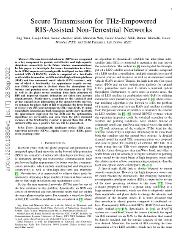| dc.contributor.author | Yuan, Jing | |
| dc.contributor.author | Chen, Gaojie | |
| dc.contributor.author | Wen, Miaowen | |
| dc.contributor.author | Tafazolli, Rahim | |
| dc.contributor.author | Panayırcı, Erdal | |
| dc.date.accessioned | 2023-10-19T15:11:56Z | |
| dc.date.available | 2023-10-19T15:11:56Z | |
| dc.date.issued | 2023 | |
| dc.identifier.issn | 0018-9545 | |
| dc.identifier.issn | 1939-9359 | |
| dc.identifier.uri | https://doi.org/10.1109/TVT.2022.3229409 | |
| dc.identifier.uri | https://hdl.handle.net/20.500.12469/5283 | |
| dc.description.abstract | The non-terrestrial networks (NTNs) are recognized as a key component to provide cost-effective and high-capacity ubiquitous connectivity in the future wireless communications. In this paper, we investigate the secure transmission in a terahertz (THz)-empowered reconfigurable intelligent surface (RIS)-assisted NTN (T-RANTN), which is composed of a low-Earth orbit satellite transmitter, an RIS-installed high-altitude platform (HAP) and two unmanned aerial vehicle (UAV) receivers, only one of which is trustworthy. An approximate ergodic secrecy rate (ESR) expression is derived when the atmosphere turbulence and pointing error due to the characteristics of THz as well as the phase errors resulting from finite precision of RIS and imperfect channel estimation are taken into account simultaneously. Furthermore, according to the statistical and perfect channel state information of the untrustworthy receiver, we optimize the phase shifts of RIS to maximize the lower bound of secrecy rate (SR) and instantaneous SR, respectively, by using semidefinite relaxation method. Simulation results show that both the approximate expression for the ESR and the optimization algorithms are serviceable, and even when the jitter standard variance of the trustworthy receiver is greater than that of the untrustworthy one, a positive SR can still be guaranteed. | en_US |
| dc.description.sponsorship | Guangdong Basic and Applied Basic Research Foundation [2021B1515120067]; National Natural Science Foundation of China [61871190] | en_US |
| dc.description.sponsorship | This work was supported in part by Guangdong Basic and Applied Basic Research Foundation under Grant 2021B1515120067 and in part by the National Natural Science Foundation of China under Grant 61871190. The review of this article was coordinated by Prof. Yiqing Zhou. | en_US |
| dc.language.iso | eng | en_US |
| dc.publisher | IEEE-Inst Electrical Electronics Engineers Inc | en_US |
| dc.relation.ispartof | Ieee Transactions on Vehicular Technology | en_US |
| dc.rights | info:eu-repo/semantics/openAccess | en_US |
| dc.subject | Discrete Phase-Shifts | En_Us |
| dc.subject | Performance Analysis | En_Us |
| dc.subject | Aided Communications | En_Us |
| dc.subject | Outage Probability | En_Us |
| dc.subject | Intelligent | En_Us |
| dc.subject | Communication | En_Us |
| dc.subject | Optimization | En_Us |
| dc.subject | Systems | En_Us |
| dc.subject | Robust | En_Us |
| dc.subject | Model | En_Us |
| dc.subject | Receivers | en_US |
| dc.subject | Low earth orbit satellites | en_US |
| dc.subject | Satellite broadcasting | en_US |
| dc.subject | Security | en_US |
| dc.subject | Terrestrial atmosphere | en_US |
| dc.subject | Atmospheric modeling | en_US |
| dc.subject | Satellites | en_US |
| dc.subject | Reconfigurable intelligent surface (RIS) | en_US |
| dc.subject | non-terrestrial networks (NTNs) | en_US |
| dc.subject | ergodic secrecy rate (ESR) | en_US |
| dc.subject | phase error | en_US |
| dc.subject | pointing error | en_US |
| dc.title | Secure Transmission for THz-Empowered RIS-Assisted Non-Terrestrial Networks | en_US |
| dc.type | article | en_US |
| dc.identifier.startpage | 5989 | en_US |
| dc.identifier.endpage | 6000 | en_US |
| dc.authorid | Chen, Gaojie/0000-0003-2978-0365 | |
| dc.authorid | Tafazolli/0000-0002-6062-8639 | |
| dc.identifier.issue | 5 | en_US |
| dc.identifier.volume | 72 | en_US |
| dc.department | N/A | en_US |
| dc.identifier.wos | WOS:000991849700035 | en_US |
| dc.identifier.doi | 10.1109/TVT.2022.3229409 | en_US |
| dc.identifier.scopus | 2-s2.0-85144786189 | en_US |
| dc.institutionauthor | N/A | |
| dc.relation.publicationcategory | Makale - Uluslararası Hakemli Dergi - Kurum Öğretim Elemanı | en_US |
| dc.authorwosid | Chen, Gaojie/AFL-8747-2022 | |
| dc.authorwosid | Tafazolli/AAF-8263-2019 | |
| dc.khas | 20231019-WoS | en_US |
















